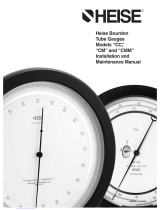
Installation and Maintenance Instructions
for ASHCROFT®L-Series Snap Action
Switches for Temperature Control
1 2 3
1 2 3
LEFT SWITCH
TERMINAL BLOCK
RIGHT SWITCH
TERMINAL BLOCK
SERVICE LEADS TO THESE TERMINALS
NC
NO
C
© 2007 Ashcroft Inc., 250 East Main Street, Stratford, CT 06614-5145, USA, Tel: 203-378-8281, Fax: 203-385-0499, www.ashcroft.com
All sales subject to standard terms and conditions of sale. I&M009-10018-10/00 (250-2873) AMR 12/-07
ELECTRICAL CONNECTION
Remove cover, held in place by two screws.
On all units except one with terminal blocks – wire directly to
the switch according to circuit requirements. Units with terminal
blocks – wire directly to terminal blocks as required. Terminals
are marked common (C), normally open (NO) and normally
closed (NC).
SETPOINT ADJUSTMENTS
Setpoints are changed by means of the setpoint adjusters. The
LT-S single switch has one adjuster and the LT-A adjustable
deadband and LT-D dual switch each have two adjusters. On
switches with two adjusters, the one on the left is referred to as
“A” and the right one is referred to as “B”; see illustration. set-
points can be adjusted from 20 to 100 percent of full range on
increasing temperature.
When adjusting temperature controls optimum performance
will be obtained if the bulb is fully immersed. After initially insert-
ing a bulb into a controlled bath, allow five minutes for stabiliza-
tion. Whenever setpoint adjustment requires a bath temperature
to be varied (such as to observesetpoint and re-setpoint val-
ues) the rate of change in temperature should not exceed 1°F
per minute. Switch operation should be monitored with a suit-
able light or meter.
SERIES LT-S SINGLE SWITCH
Remove cover. For setpoint adjustment on either increasing or
decreasing temperature, the bulb of the control should be im-
mersed in a bath at the desired setpoint temperature. Optimum
performance will be obtained if bulb is fully immersed. Allow five
minutes for initial stabilization. Monitor switch with a light or meter.
If setpoint is on increasing temperature, turn adjuster so that
switch operates (if common-normally closed circuit is being
monitored light goes off). If setpoint is on decreasing tempera-
ture, turn adjuster so that switch resets (if common-normally
closed circuit is being monitored light comes on). When the
setpoint has been achieved, raise and lower the temperature to
ensure that the setpoint is correct.
The deadband (difference between the operate and reset
temperatures) may be verified at this time to be between the
values noted on the nameplate label.
SERIES LT-D DUAL SWITCH
Remove cover. Immerse the bulb and monitor the switch as
described under Series LT-S Single Switch. Also see discussion
of increasing or decreasing setpoints and deadband verification.
The initial bath temperature should be the higher setpoint. Turn
adjuster “B” until the switch operates or resets as required.
When the setpoint has been achieved, raise and lower the bath
temperature to ensure that the setpoint is correct. Then reduce
the bath temperature to the lower setpoint and turn adjuster “A”
until the switch operates or resets as required. Verify this set-
point byraising and lowering bath temperature. Now increase
the temperature to the higher setpoint and make final adjust-
ment on “B.”
SERIES LT-A ADJUSTABLE DEADBAND SWITCH
Remove cover. Adjuster “B” controls the operating point of the
switch on increasing temperature.Adjuster “A” controls the re-
setpoint of the switch on decreasing temperature.
Immerse the bulb and monitor the switch as described under
single switch setpoint adjustment. With the bath at the required
setpoint temperature, turn adjuster “B” until switch operates.
Then lower the bath temperature to the re-setpoint and turn
adjuster “A” until the switch resets. Now increase the tempera-
ture to the operating point and make final adjustment on “B.”
Raise and lower temperature to ensure that the setpoint and
re-setpoint are correct.
SOME PRECAUTIONS TO OBSERVE
Do not loosen the screws holding the precision switch ele-
ment(s) or mounting bracket in place.
Nameplate PROOF temperature should not be exceeded.
Intermittent operation up to proof temperature is permissible,
however, some change of setpoint may be noted.
Operation and correct setpoint actuation should be routinely
tested.








